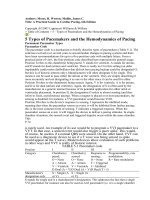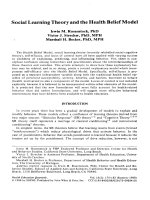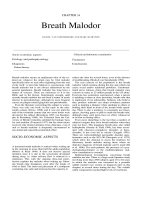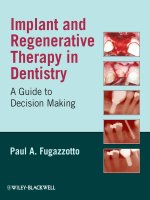Orthodontics and Paediatric Dentistry: Colour Guide pptx
Bạn đang xem bản rút gọn của tài liệu. Xem và tải ngay bản đầy đủ của tài liệu tại đây (8.37 MB, 172 trang )
CHURCHILL LIVINGSTONE
An imprint of Harcourt Publishers Limited
© Harcourt Publishers Limited 2000
The right of Declan Millett and Richard Welbury
to be identified as authors of this work has been
asserted by them in accordance with the
Copyright, Designs and Patents Act 1988
All rights reserved. No part of this publication
may be reproduced, stored in a retrieval system,
or transmitted in any form or by any means,
electronic, mechanical, photocopying, recording
or otherwise, without either the prior permission
of the publishers (Harcourt Publishers Limited,
Harcourt Place, 32 Jamestown Road, London
NW1 7BY), or a licence permitting restricted
copying in the United Kingdom issued by the
Copyright Licensing Agency, 90 Tottenham Court
Road, London W1P OLP
ISBN 0443 06287 0
British Library Cataloguing in Publication Data
A catalogue record for this book is available from
the British Library.
Library of Congress Cataloging in Publication Data
A catalog record for this book is available from
the Library of Congress.
Printed in China
SWTC/01
Note
Medical knowledge is constantly
changing. As new information
becomes available, changes in
treatment, procedures, equipment
and the use of drugs become
necessary. The authors and the
publishers have, as far as it is
possible, taken care to ensure
that the information given in this
text is accurate and up to date.
However, readers are strongly
advised to confirm that the
i
nformation, especially with
regard to drug usage, complies
with the latest legislation and
standards of practice.
For Churchill Livingstone
Commissioning Editor:
Mike Parkinson
Project
Development Manager:
Sarah Keer-Keer & Sian Jarman
Project Controller: Frances Affleck
Designer:
Erik Bigland
The
publisher's
policy is to use
paper manufactured
from sustainable forests
The clinical interface of orthodontics and paediatric dentistry is
broad. Increasingly, for the undergraduate, teaching and
examinations in these specialties are combined to promote a
holistic approach to dental care for the child and adolescent patient.
This concise colour guide aims, therefore, to cover major clinical
aspects of orthodontic and paediatric dental practice in a format
suitable for quick reference and revision purposes. It assumes a
good working knowledge and competence in history taking/clinical
examination as well as an understanding of the principles of
treatment planning for both disciplines. Space restrictions preclude
the inclusion of some topics which are dealt with comprehensively
i
n specialist texts (listed under Recommended Reading). Although
directed primarily at the undergraduate, we hope that this colour
guide will be of value also to the junior postgraduate and to those
preparing for membership examinations.
We wish to acknowledge particularly the help and support of Mrs K.
Shepherd, Mrs G. Drake, Mr J. Davies (Glasgow Dental Hospital and
School) and Mr B. Hill and Mrs J. Howarth (Newcastle upon Tyne
Dental Hospital) in the preparation of photographic material. We
would also like to thank Mr A. Shaw (Fig. 27b), Miss D. Fung (Fig.
28),
Mr J. G. McLennan (Figs. 68, 100, 101, 103), Dr L-H. Teh (Figs.
78, 84) and Miss J. Hickman (Fig. 85). The Index of Orthodontic
Treatment Need is reproduced by kind permission of VUMAN
Limited.
We also thank the staff of Harcourt Health Sciences who
have been very helpful throughout. Finally we pay special tribute to
Eithne Johnstone for her considerable skill and advice in preparing
and text editing the initial drafts of the manuscript.
Glasgow and Newcastle upon Tyne
2000
R. R. W.
D. T. M.
Definition
The changes one would expect in the 'average'
child. For average eruption dates see page 83.
Primary dentition
I
ncisors are usually spaced and upright. No
spacing indicates the probable crowding of
successors (Fig. 1). 'Primate' spacing may exist
distal to cs and mesial to
cs.
Distal surfaces of es
are flush in most cases. By 5-6 years, an edge-to-
edge occlusion with incisor attrition is common.
Primary to mixed dentition
• 1 1 or
6s
are usually the first to erupt; mild
i
ncisor crowding is common (Fig. 2) but tends
to resolve by 9 years with an increase of about
2-3mm in intercanine width.
• Space for
21[12
i
s provided by existing incisor
spacing, by intercanine width growth, and by
their greater proclination than ba ab.
111
are usually distally inclined initially; median
diastema reduces with
212
eruption. As 3 3
migrate and press on the roots of
212,
their
crowns, and to a lesser extent those of
111,
are
frequently flared distally with a median diastema
-'ugly duckling' stage (Fig. 3). This usually
corrects as 3s erupt.
• Space for 3, 4, 5s is provided by the slightly
greater mesiodistal width of c, d, es. Greater
l
eeway space in the mandible (-2-2.5mm) than
i
n the maxilla (-1-1.5mm) with mandibular
growth creates a Class I molar relationship.
Dental arch development
With the exception of intercanine width increase,
dental arch size alters minimally after the primary
dentition erupts. Permanent molars are accom-
modated by growth at the back of the arch.
Alveolar bone growth maintains occlusal contact
as the face grows vertically.
Static occlusal relations (Andrews' six keys)
•
Molar relationship
(
Fig. 4). Distal surface of the
distal
marginal ridge of 6 contacts and occludes
with the mesial surface of the mesial marginal
ridge of
7;
the mesiobuccal cusp of 6 lies in the
_groove between the mesial and middle cusps of
6; the mesiolingual cusp of 6 seats in the central
fossa of
6.
• Crown angulation.
Gingival aspect of the long
axis of each crown lies distal to its occlusal
aspect.
• Crown inclination.
The gingival aspect of the
l
abial surface of the crown of
21112
li
es palatal to
the incisal aspect. Otherwise, the gingival aspect
of the labial or buccal surface of the crowns of
all
other teeth lies labial or buccal to the
i
ncisal/occlusal aspect.
• No rotations.
• No spaces.
• Flat or mildly increased (<_1.5mm) curve of Spee.
Functional occlusal relations
• Centric relation should coincide with centric
occlusion.
• A working side canine rise (Fig. 5) or group
function should be present on lateral excursions,
with no occlusal contact on the non-working
side; the incisors should only contact in
protrusion.
Maturational changes in the occlusion
• Increase in lower incisor crowding (Fig. 6).
• Slight increase in interincisal angle with incisor
uprighting.
• Slight increase in mandibular prognathism.
Fig. 5 Canine guided right lateral excursion; note that no non-
working side contacts were present.
Fig. 6 Late lower incisor crowding.
Fig. 4 Normal molar relationship.
Fig. 8 Class II molar ll Dlvlsion 1 incisor relatior
!,
Fig. 9 Half unit Class II molar/II Division 2 incisor relationship.
Fig. 10 Class III molar and incisor relationships.
Classification to assess treatment need
Index of
Helps to identify those malocclusions most likely to
orthodontic
benefit in dental health and appearance from
treatment need
orthodontic treatment; comprises two components:
(I
OTN)
•
Dental health component (DHC)
• Aesthetic component (AC).
Dental health component (DHC)
(
Fig. 11 a).
Malocclusion
categorised objectively into five treatment grades,
from no need (Grade 1) to very great need (Grade
5).
Occlusal features are assessed in the following
order: missing teeth (M), overjet (O), crossbite (C),
displacement of contact points, i.e. crowding (D),
overbite (O), giving the acronym MOCDO. A ruler
(
Fig. 11 b) facilitates the grading process.
GRADE 5 (Need treatment)
5.i
I
mpeded eruption of teeth (except for third
molars) due to crowding, displacement, the
presence of supernumerary teeth, retained
deciduous teeth and any pathological cause.
5.h
Extensive hypodontia with restorative
i
mplications (more than 1 tooth missing in
any quadrant) requiring pre-restorative
orthodontics.
5.a Increased overjet greater than 9nmt.
5.m Reverse overjet greater than 3.5mm with
reported masticatory and speech difficulties.
5.p
Defects of cleft lip and palate and other
craniofacial
anomalies.
5.s
Submerged deciduous teeth.
GRADE 4 (Need treatment)
4.h Less extensive hypodontia requiring
prerestorative orthodontics or orthodontic
space closure to obviate the need for a
prosthesis.
4.a Increased overjet greater than 6mm but less
than or equal to 9mm.
4.6
Reverse overjet greater than 3.5 mm with no
masticatory or speech difficulties.
4.m Reverse overjet greater than I mm but less
than 3.5mm with recorded masticatory and
speech difficulties.
4.c
4.1
Posterior lingual crossbite with no functional
occlusal contact in one or both buccal segments.
4.d Severe contact point displacements greater
than 4mm.
4.e
Extreme lateral or anterior open bites greater
than 4mm.
4.f Increased and complete overbite with
gingival or palatal trauma.
4.t
Partially erupted teeth, tipped and impacted
against adjacent teeth.
4.x Presence of supernumerary teeth.
Fig. 11a Dental health component of the index of orthodontic treatment need.
Anterior or posterior crossbites with greater
than 2mm discrepancy between retruded
contact position and intercuspal position.
GRADE 3 (Borderline need)
3.a Increased overjet greater than 3.5min but less
than or equal to 6mm. with incompetent lips.
3.b
Reverse overjet greater than I mm but less
than or equal to 3.5mm.
3.c
Anterior or posterior crossbites with greater
than Imm but less than or equal to 2mm
discrepancy between retruded contact
position and intercuspal position.
3.d
Contact point displacements greater than
2mm but less than or equal to 4mm.
3.e
Lateral or anterior open bite greater than
2mm but less than or equal to 4mm.
3.f
Deep overbite complete on gingival or palatal
tissues but no trauma.
GRADE 2 (Little)
2.a Increased overjet greater than 3.5mm but less
than or equal to 6mm with competent lips.
2.b
Reverse overjet greater than Omm but less
than or equal to I mm.
2.c
Anterior or posterior crossbite with less than
or equal to I mm discrepancy between
retruded contact position and intercuspal
position.
2.d
Contact point displacements greater than
I
mm but less than or equal to 2mm.
2.e
Anterior or posterior openbite greater than
I
mm but less than or equal to 2mm
2.f
Increased overbite greater than or equal to
3.5mm without gingival contact.
2.g
Pre-normal or post-normal occlusions with
no other anomalies (includes up to half a unit
discrepancy).
GRADE 1 (None)
1.
Extremely minor malocclusions including
contact point displacements less than I mm.
Fig. 11b Index of orthodontic treatment need ruler.
Index of
orthodontic
treatment need
(IOTN) (contd)
Aesthetic component
(AC) (Fig. 12).
Uses a set of 10
photographs of anterior occlusion with increasing
aesthetic impairment. Assessment is made by
selecting the photograph thought to match the
aesthetic handicap of the case. Treatment need is
categorised as follows: score 1-2 = no need; 3-7 -
borderline need; 8-10 = definite need. The method
suffers from subjectivity.
Classification to assess treatment outcome
Objective assessment using DHC of IOTN, and
subjective assessment by AC of IOTN. Peer
assessment rating (PAR) may be recorded also. Six
aspects, each given a different weighting, of the
pre- and post-treatment occlusion may be assessed
from study models with the aid of a ruler (Fig. 13).
The percentage change in the PAR score measures
success. A 70% reduction in the PAR score
i
ndicates 'greatly improved' occlusion, while
'
worse/no different' is indicated by <- 20% reduction
i
n ernrc
Fig. 12 Aesthetic component of the index of orthodontic treatment need.
Fig. 13 Peer assessment rating
Definition
Taking the
radiograph
Indications
Uses of lateral
cephalometric
analysis
Aim
Objective
Evaluation and interpretation of both lateral and
posteroanterior (PA) radiographs of the head
(
usually confined to the former).
Standardised technique to ensure reproducibility
and minimise magnification:
Frankfort plane horizontal, ear posts in the
external auditory canal with the central X-ray beam
directed through them, teeth in centric occlusion,
X-ray source at a fixed distance to the midsagittal
plane (about 152.5cm) and to the film (see Fig. 14).
Collimate the beam to reduce radiation exposure.
An aluminium wedge enables the soft tissues to be
demonstrated (Fig. 15).
When anteroposterior and/or vertical skeletal
discrepancies are present (Fig. 15); when
anteroposterior incisor movement is planned in
these cases.
• To aid diagnosis by allowing dental and skeletal
characteristics of a malocclusion to be assessed.
• To check treatment progress during fixed or
functional treatments and to monitor the position
of unerupted teeth.
• To assess treatment and growth changes by
superimposing radiographs or tracings on
reasonably stable areas: cranial base or its
approximation (S-N line holding at S; Fig. 16);
anterior vault of the palate; Bjork's structures in
the mandible.
Aim and objective of cephalometric analysis
To assess the anteroposterior and vertical
relationships of the upper and lower teeth with
supporting alveolar bone to their respective
maxillary and mandibular bases and to the cranial
base.
To compare the patient to normal population
standards appropriate for his/her racial group,
i
dentifying any differences between the two.
Fig. 14 Patient in a cephalostat.
Skeletal
relationships
Tooth position
Practice of cephalometric analysis
Ensure that teeth are in occlusion and that the
patient is not postured forward.
I
n a darkened room, by tracing or digitising,
calculate angular/linear measurements; identify the
points and planes shown in Fig. 17; always trace
the most prominent image. For structures with two
i
mages (e.g. the mandibular border), trace both
and take the average for gonion.
Cephalometric interpretation
For Caucasians, compare individual values with
Eastman norms:
SNA 81° ± 3°; SNB 78° ± 3°; ANB 3° ± 2°; S-N/Max
plane 8° ± 3°; 1 to Max plane 109° ± 6°; T to Mand
plane 93° ± 6°; Interincisal angle 135° ± 10°; MMPA
27° ± 4°; Facial % 55 ± 2%.
A-P.
I
f
SNA < or > 81° and S-N/Max PL within 8° ±
3°, correct ANB as follows: for every °SNA > 81°,
subtract 0.5° from ANB value and vice versa.
Vertical.
MMPA and Facial % should lend support
to each other usually.
• To assess if overjet reduction is possible by
tipping movement, do a prognosis tracing (Fig.
18), or for every 1 mm of overjet reduction
subtract 2.5° from _1 inclination. If the final
i
nclination is not < 95° to maxillary plane, tipping
i
s acceptable.
•
Check 1
angulation to mandibular plane in
conjunction with ANB and MMPA. There is an
i
nverse relationship between 1 angulation and
MMPA.
• Interincisal angle: as this increases, overbite
deepens.
• 1 to APo: this is an aesthetic reference line but it
i
s unwise to use for treatment planning
purposes.
Soft tissue
Useful for orthognathic planning.
analysis
•
Holdaway
line: lower lip should be ±1 mm to this
li
ne.
• Ricketts' E-line: lower lip should be 2 mm
(
±2 mm) in front of this with the upper lip
slightly behind.
Fig. 17 Cephalometric points, planes and angles.
Points: S (Sella); N (Nasion); Po (Porion);
Or (Orbitale); A ('A'point); B ('B'point); Pog (Pogonion); Me (Menton); Go (Gonion). Planes:
Frankfort (Po-Or); Maxillary (ANS-PNS); Mandibular (Go-Me).
Overjet reduction by tipping movement unacceptable
(note upper incisor root through labial plate)
Fig. 18 Prognosis tracing.
Intention
Indications
Shortcomings
Contemporary
view
Serial extraction
Ascribed by Kjellgren* in 1948 to the following:
• Extraction of cs at age 8.5-9.5 years to
encourage the alignment of permanent incisors.
• Extraction of ds about 1 year later to encourage
the eruption of 4s.
• Extraction of 4s as 3s are erupting.
To remove the need for appliance therapy.
Works best in Class I cases at about 9 years with
moderate crowding, average overbite and a full
complement of teeth, where there is no doubt
about the long-term prognosis of 6s.
• Seldom removes need for further appliance
therapy.
• As three episodes of extractions are required,
often under general anaesthesia, the full extent
of the original technique is never adopted
nowadays.
Consider removal of _cs:
•
when 2 erupting in potential crossbite (Fig. 22a)
• to create space for proclination of 2 or the
eruption of an incisor when a supernumerary
has delayed its appearance
• to promote alignment of a palatally displaced 3
(
Fig. 23).
Consider removal of cs:
• to facilitate lingual movement of a lower incisor
with reduced periodontal support
• to allow lingual movement of the lower labial
segment in some Class III cases (Fig. 22a, b).
* Kjellgren B 1948 Serial extraction as a corrective procedure in dental
orthopaedic therapy. Acta Odontologica Scandinavica 8: 17-43
(
see also p. 101)
Mesiodens
Orthodontic
management
Conical.
These commonly exist between
J11
(
Fig.
24), often singularly, but sometimes in combination
with others of similar form.
Treatment.
a.
None - if it/they are well above the apices of
111,
and if there is no risk of damage to adjacent
teeth with tooth movement, leave and observe
b.
Remove - if it/they are displacing adjacent teeth
producing a large diastema or delaying eruption
of 1. Also remove a conical supernumerary if it
erupts.
Tuberculate.
The most common cause of unerupted
1
(
Fig. 25). May be barrel-shaped.
Treatment: remove supernumerary and any
retained primary incisors followed by bonding of
gold chain or a magnet to the unerupted incisor
to allow provision for alignment if spontaneous
eruption is not forthcoming within 18 months of
surgery. Often removal of cs is also required and
URA to move
2L2
distally to create space for 1.
Supplemental.
Resembles a normal tooth in
morphology and commonly produces crowding or
displacement of teeth (Fig. 26).
Treatment: extract the tooth most dissimilar to
the contralateral tooth, provided the more normal
tooth is not severely displaced.









